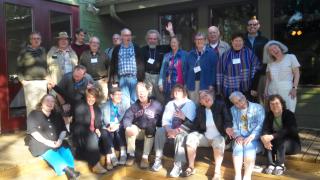Advertisement
There is a shortage of interim ministers for Unitarian Universalist congregations this year. According to the Unitarian Universalist Association, the drop may herald a shortage of ministers for other congregational positions, too.
Currently, 32 Unitarian Universalist congregations are searching for an interim minister, but there are only 28 accredited or experienced interim ministers available, said the Rev. Keith Kron, the UUA’s transitions director.
“In the last two years of interim search, we have not had enough ministers to fill all the positions,” Kron told UU World. Last year, the shortage mainly affected congregations searching for a part-time minister, but this year there may also be congregations that won’t find someone to serve as a full-time interim.
It’s an “unprecedented situation . . . that has not occurred in the recent history of Unitarian Universalism,” according to an announcement in May by the Central East Region staff of the UUA. The problem is national, although the announcement came from the Central East Regional Group, which had invited Kron to speak to congregations there about their struggles in finding interims.
“This is the first time where I have worried about congregations that I would never have expected having trouble getting an interim,” said Kron, who’s served as transitions director for five years.
The Rev. David Pyle, district executive of the Joseph Priestley District in the Central East Regional Group, is working with four congregations that are struggling to find some form of interim or transitional minister. One congregation made multiple offers that were turned down, he said. Kron was invited to speak to congregational leaders to “help them know it wasn’t necessarily about them but was about a larger dynamic,” said Pyle, “and to help them stay in it, because it can be demoralizing.”
After Kron’s visit, the regional staff issued the announcement, which also said that for the near future, “a congregation simply cannot expect, when a minister leaves (or is encouraged to leave by congregants), that there will be a deep pool of candidates for that open ministerial position.”
In recent years, the UUA has accredited approximately six new interim ministers each year. This year, in what Kron hopes was an anomaly, only two ministers entered the interim training program. At the same time, the number of ministers entering the search process for other positions dropped from 130 to 110.
The shortage of interims may have a ripple effect on small congregations that have relied on part-time ministers as their settled ministers. Those clergy may now choose to become interims instead, Pyle said.
The improved U.S. economy appears to be the primary source of the problem, said Kron, who interviews each UU minister in transition. Ministers who put off retiring or who came out of retirement when the economy was in trouble can now afford to stop working, he’s found. Many of them served as interims.
An average of 30 ministers a year retired in Kron’s first three years as transitions director. But in the past two years, that number has more than doubled, with 61 ministers a year retiring. Pyle said he personally knows four or five ministers who have now decided to retire after holding off until the economy improved.
Location seems to be one factor in the shortage of interim clergy. “Ministry is becoming a second-income profession,” Kron said, “or at least a two-income profession. Interims are getting pickier about traveling and moving costs.”
The Rev. Dawn Sangrey is currently serving as assistant minister of the UU Fellowship of Northern Westchester in Mount Kisco, New York, and temporarily helping out the settled minister who has a young child. Sangrey said she is happy to continue to fill in for her colleagues—but only near her home, as her husband doesn’t want to move. “If there were an interim ministry job within commuting distance of my home, I’d certainly look at it,” said Sangrey, who is 73. “For me, geography is the prime factor, and that has to do with my age and my family situation.”
The financial demands also include serving in congregations that don’t completely reimburse interim ministers for attending General Assembly, district meetings, or professional trainings, said the Rev. Linda Bunyard. “I have said many times that interim ministry is redeeming for both the minister and the congregation,” said Bunyard, who retired last year at age 62 after seven straight years of interim service, preceded by both settled and interim experience. “That said, it was so physically, emotionally, and financially difficult to pick up and leave after one or two years with a congregation.”
Another factor in the shortage may be that more ministers are choosing to go into social justice work and other settings rather than serve in a congregation, said Pyle.
The interim shortage may mean that congregations will rethink how they approach their relationships with their ministers, said Kron, who will be discussing the issue in a workshop he’s leading later this month during the UUA’s General Assembly in Portland, Oregon, entitled “Navigating Ministerial Transitions.”
If a minister has shortcomings, a congregation may want to consider investing in training her or him rather than searching for a new minister, Kron said. For example, the congregation could choose to invest in their minister learning about stewardship and fundraising if that’s a weak area. At the same time, he said, “You should maintain the standards for what you want in a minister.”
With reporting by Christopher L. Walton.
